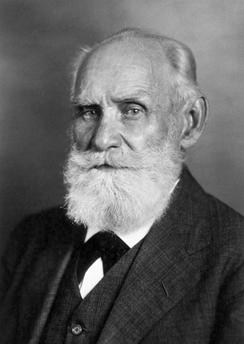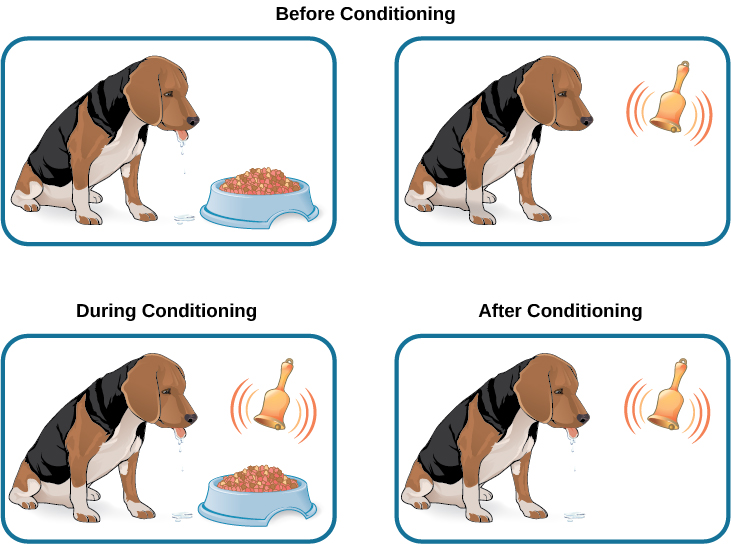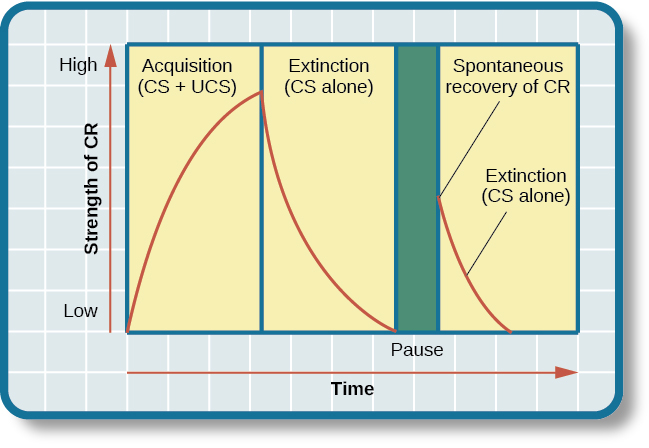33 Classical Conditioning
Learning Objectives
By the end of this section, you will be able to:
- Explain how classical conditioning occurs
- Summarize the processes of acquisition, extinction, spontaneous recovery, generalization, and discrimination
Does the name Ivan Pavlov ring a bell? Even if you are new to the study of psychology, chances are that you have heard of Pavlov and his famous dogs.
Pavlov (1849–1936), a Russian scientist, performed extensive research on dogs and is best known for his experiments in classical conditioning. As we discussed briefly in the previous section, classical conditioning is a process by which we learn to associate stimuli and, consequently, to anticipate events.

Pavlov came to his conclusions about how learning occurs completely by accident. Pavlov was a physiologist, not a psychologist. Physiologists study the life processes of organisms, from the molecular level to the level of cells, organ systems, and entire organisms. Pavlov’s area of interest was the digestive system (Hunt, 2007). In his studies with dogs, Pavlov surgically implanted tubes inside dogs’ cheeks to collect saliva. He then measured the amount of saliva produced in response to various foods. Over time, Pavlov (1927) observed that the dogs began to salivate not only at the taste of food, but also at the sight of food, at the sight of an empty food bowl, and even at the sound of the laboratory assistants’ footsteps. Salivating to food in the mouth is reflexive, so no learning is involved. However, dogs don’t naturally salivate at the sight of an empty bowl or the sound of footsteps.
These unusual responses intrigued Pavlov, and he wondered what accounted for what he called the dogs’ “psychic secretions” (Pavlov, 1927). To explore this phenomenon in an objective manner, Pavlov designed a series of carefully controlled experiments to see which stimuli would cause the dogs to salivate. He was able to train the dogs to salivate in response to stimuli that clearly had nothing to do with food, such as the sound of a bell, a light, and a touch on the leg. Through his experiments, Pavlov realized that an organism has two types of responses to its environment: (1) unconditioned (unlearned) responses, or reflexes, and (2) conditioned (learned) responses.
In Pavlov’s experiments, the dogs salivated each time meat powder was presented to them. The meat powder in this situation was an unconditioned stimulus (UCS): a stimulus that elicits a reflexive response in an organism. The dogs’ salivation was an unconditioned response (UCR): a natural (unlearned) reaction to a given stimulus. Before conditioning, think of the dogs’ stimulus and response like this:
In classical conditioning, a neutral stimulus is presented immediately before an unconditioned stimulus. Pavlov would sound a tone (like ringing a bell) and then give the dogs the meat powder. The tone was the neutral stimulus (NS), which is a stimulus that does not naturally elicit a response. Prior to conditioning, the dogs did not salivate when they just heard the tone because the tone had no association for the dogs. Quite simply this pairing means:
Tone (NS) + Meat Powder (UCS) → Salivation (UCR)
When Pavlov paired the tone with the meat powder over and over again, the previously neutral stimulus (the tone) also began to elicit salivation from the dogs. Thus, the neutral stimulus became the conditioned stimulus (CS), which is a stimulus that elicits a response after repeatedly being paired with an unconditioned stimulus. Eventually, the dogs began to salivate to the tone alone, just as they previously had salivated at the sound of the assistants’ footsteps. The behavior caused by the conditioned stimulus is called the conditioned response (CR). In the case of Pavlov’s dogs, they had learned to associate the tone (CS) with being fed, and they began to salivate (CR) in anticipation of food.

View this video to learn more about Pavlov and his dogs: Classical Conditioning – Ivan Pavlov.
General Processes in Classical Conditioning
Now that you know how classical conditioning works and have seen several examples, let’s take a look at some of the general processes involved. In classical conditioning, the initial period of learning is known as acquisition, when an organism learns to connect a neutral stimulus and an unconditioned stimulus. During acquisition, the neutral stimulus begins to elicit the conditioned response, and eventually the neutral stimulus becomes a conditioned stimulus capable of eliciting the conditioned response by itself. Timing is important for conditioning to occur. Typically, there should only be a brief interval between the presentation of the conditioned stimulus and the unconditioned stimulus. Depending on what is being conditioned, sometimes this interval is as little as five seconds (Chance, 2009). However, with other types of conditioning, the interval can be up to several hours.
Taste aversion is a type of conditioning in which an interval of several hours may pass between the conditioned stimulus (something ingested) and the unconditioned stimulus (nausea or illness). Here’s how it works. Between classes, you and a friend grab a quick lunch from a food cart on campus. You share a dish of chicken curry and head off to your next class. A few hours later, you feel nauseous and become ill. Although your friend is fine and you determine that you have intestinal flu (the food is not the culprit), you’ve developed a taste aversion; the next time you are at a restaurant and someone orders curry, you immediately feel ill. While the chicken dish is not what made you sick, you are experiencing taste aversion: you’ve been conditioned to be averse to a food after a single, negative experience.
How does this occur—conditioning based on a single instance and involving an extended time lapse between the event and the negative stimulus? Research into taste aversion suggests that this response may be an evolutionary adaptation designed to help organisms quickly learn to avoid harmful foods (Garcia & Rusiniak, 1980; Garcia & Koelling, 1966). Not only may this contribute to species survival via natural selection, but it may also help us develop strategies for challenges such as helping cancer patients through the nausea induced by certain treatments (Holmes, 1993; Jacobsen et al., 1993; Hutton, Baracos, & Wismer, 2007; Skolin et al., 2006).
Once we have established the connection between the unconditioned stimulus and the conditioned stimulus, how do we break that connection and get the dog, cat, or child to stop responding? In Tiger’s case, imagine what would happen if you stopped using the electric can opener for her food and began to use it only for human food. Now, Tiger would hear the can opener, but she would not get food. In classical conditioning terms, you would be giving the conditioned stimulus, but not the unconditioned stimulus. Pavlov explored this scenario in his experiments with dogs: sounding the tone without giving the dogs the meat powder. Soon the dogs stopped responding to the tone. Extinction is the decrease in the conditioned response when the unconditioned stimulus is no longer presented with the conditioned stimulus. When presented with the conditioned stimulus alone, the dog, cat, or other organism would show a weaker and weaker response, and finally no response. In classical conditioning terms, there is a gradual weakening and disappearance of the conditioned response.
What happens when learning is not used for a while—when what was learned lies dormant? As we just discussed, Pavlov found that when he repeatedly presented the bell (conditioned stimulus) without the meat powder (unconditioned stimulus), extinction occurred; the dogs stopped salivating to the bell. However, after a couple of hours of resting from this extinction training, the dogs again began to salivate when Pavlov rang the bell. What do you think would happen with Tiger’s behavior if your electric can opener broke, and you did not use it for several months? When you finally got it fixed and started using it to open Tiger’s food again, Tiger would remember the association between the can opener and her food—she would get excited and run to the kitchen when she heard the sound. The behavior of Pavlov’s dogs and Tiger illustrates a concept Pavlov called spontaneous recovery: the return of a previously extinguished conditioned response following a rest period.

Of course, these processes also apply to humans. For example, let’s say that every day when you walk to campus, an ice cream truck passes your route. Day after day, you hear the truck’s music (neutral stimulus), so you finally stop and purchase a chocolate ice cream bar. You take a bite (unconditioned stimulus) and then your mouth waters (unconditioned response). This initial period of learning is known as acquisition, when you begin to connect the neutral stimulus (the sound of the truck) and the unconditioned stimulus (the taste of the chocolate ice cream in your mouth). During acquisition, the conditioned response gets stronger and stronger through repeated pairings of the conditioned stimulus and unconditioned stimulus. Several days (and ice cream bars) later, you notice that your mouth begins to water (conditioned response) as soon as you hear the truck’s musical jingle—even before you bite into the ice cream bar. Then one day you head down the street. You hear the truck’s music (conditioned stimulus), and your mouth waters (conditioned response). However, when you get to the truck, you discover that they are all out of ice cream. You leave disappointed. The next few days you pass by the truck and hear the music, but don’t stop to get an ice cream bar because you’re running late for class. You begin to salivate less and less when you hear the music, until by the end of the week, your mouth no longer waters when you hear the tune. This illustrates extinction. The conditioned response weakens when only the conditioned stimulus (the sound of the truck) is presented, without being followed by the unconditioned stimulus (chocolate ice cream in the mouth). Then the weekend comes. You don’t have to go to class, so you don’t pass the truck. Monday morning arrives and you take your usual route to campus. You round the corner and hear the truck again. What do you think happens? Your mouth begins to water again. Why? After a break from conditioning, the conditioned response reappears, which indicates spontaneous recovery.
Acquisition and extinction involve the strengthening and weakening, respectively, of a learned association. Two other learning processes—stimulus discrimination and stimulus generalization—are involved in distinguishing which stimuli will trigger the learned association. Animals (including humans) need to distinguish between stimuli—for example, between sounds that predict a threatening event and sounds that do not—so that they can respond appropriately (such as running away if the sound is threatening). When an organism learns to respond differently to various stimuli that are similar, it is called stimulus discrimination. In classical conditioning terms, the organism demonstrates the conditioned response only to the conditioned stimulus. Pavlov’s dogs discriminated between the basic tone that sounded before they were fed and other tones (e.g., the doorbell), because the other sounds did not predict the arrival of food. Similarly, Tiger, the cat, discriminated between the sound of the can opener and the sound of the electric mixer. When the electric mixer is going, Tiger is not about to be fed, so she does not come running to the kitchen looking for food.
On the other hand, when an organism demonstrates the conditioned response to stimuli that are similar to the condition stimulus, it is called stimulus generalization, the opposite of stimulus discrimination. The more similar a stimulus is to the condition stimulus, the more likely the organism is to give the conditioned response. For instance, if the electric mixer sounds very similar to the electric can opener, Tiger may come running after hearing its sound. But if you do not feed her following the electric mixer sound, and you continue to feed her consistently after the electric can opener sound, she will quickly learn to discriminate between the two sounds (provided they are sufficiently dissimilar that she can tell them apart).
Sometimes, classical conditioning can lead to habituation. Habituation occurs when we learn not to respond to a stimulus that is presented repeatedly without change. As the stimulus occurs over and over, we learn not to focus our attention on it. For example, imagine that your neighbor or roommate constantly has the television blaring. This background noise is distracting and makes it difficult for you to focus when you’re studying. However, over time, you become accustomed to the stimulus of the television noise, and eventually you hardly notice it any longer.
Test Your Understanding
Review Questions
Critical Thinking Questions
If the sound of your toaster popping up toast causes your mouth to water, what are the UCS, CS, and CR?
The food being toasted is the UCS; the sound of the toaster popping up is the CS; salivating to the sound of the toaster is the CR.
Explain how the processes of stimulus generalization and stimulus discrimination are considered opposites.
In stimulus generalization, an organism responds to new stimuli that are similar to the original conditioned stimulus. For example, a dog barks when the doorbell rings. He then barks when the oven timer dings because it sounds very similar to the doorbell. On the other hand, stimulus discrimination occurs when an organism learns a response to a specific stimulus, but does not respond the same way to new stimuli that are similar. In this case, the dog would bark when he hears the doorbell, but he would not bark when he hears the oven timer ding because they sound different; the dog is able to distinguish between the two sounds.
How does a neutral stimulus become a conditioned stimulus?
This occurs through the process of acquisition. A human or an animal learns to connect a neutral stimulus and an unconditioned stimulus. During the acquisition phase, the neutral stimulus begins to elicit the conditioned response. The neutral stimulus is becoming the conditioned stimulus. At the end of the acquisition phase, learning has occurred and the neutral stimulus becomes a conditioned stimulus capable of eliciting the conditioned response by itself.
Personal Application Question
Can you think of an example in your life of how classical conditioning has produced a positive emotional response, such as happiness or excitement? How about a negative emotional response, such as fear, anxiety, or anger?
Summary
Pavlov’s pioneering work with dogs contributed greatly to what we know about learning. His experiments explored the type of associative learning we now call classical conditioning. In classical conditioning, organisms learn to associate events that repeatedly happen together, and researchers study how a reflexive response to a stimulus can be mapped to a different stimulus—by training an association between the two stimuli. Pavlov’s experiments show how stimulus-response bonds are formed. Watson, the founder of behaviorism, was greatly influenced by Pavlov’s work. He tested humans by conditioning fear in an infant known as Little Albert. His findings suggest that classical conditioning can explain how some fears develop.

